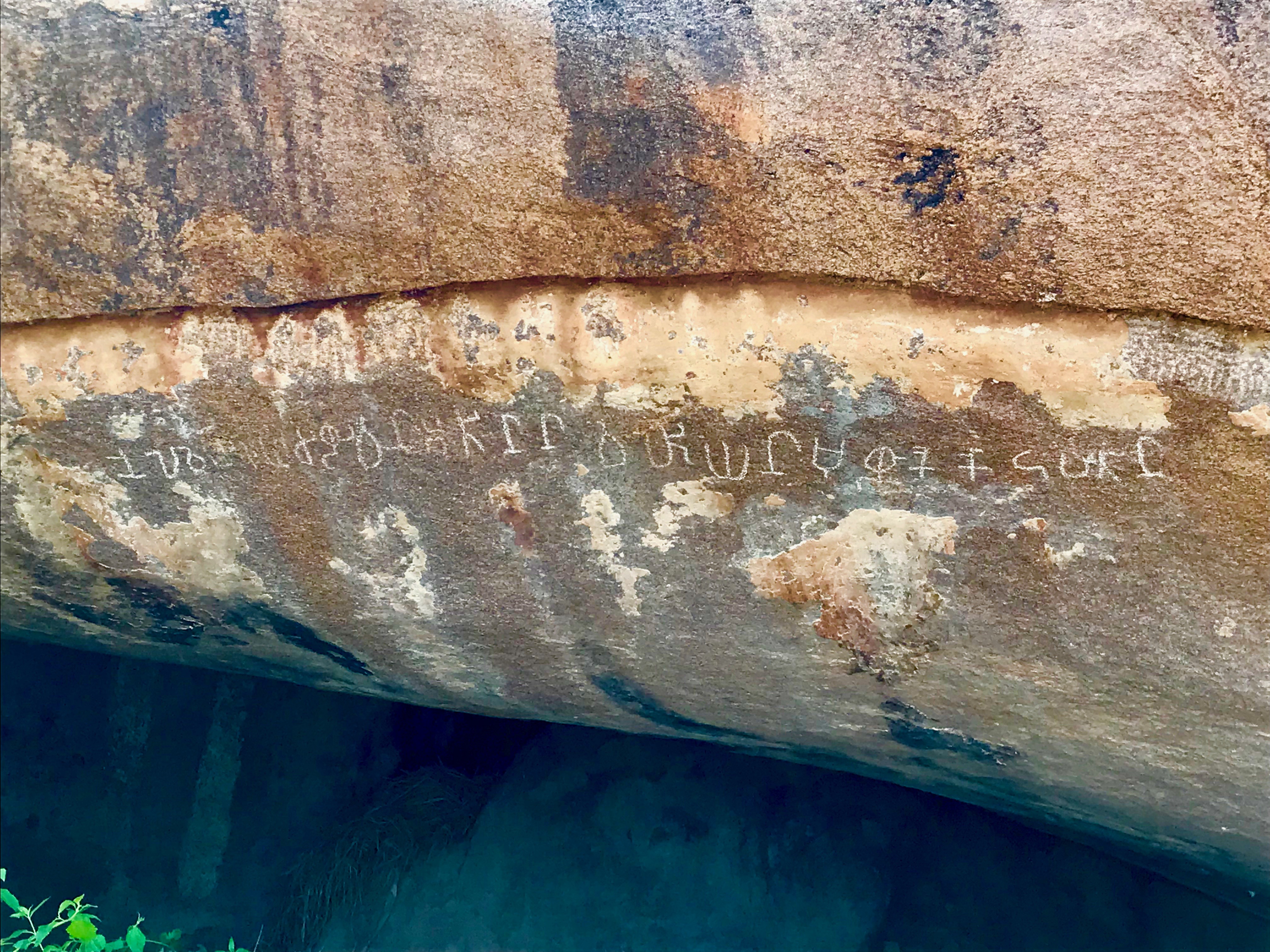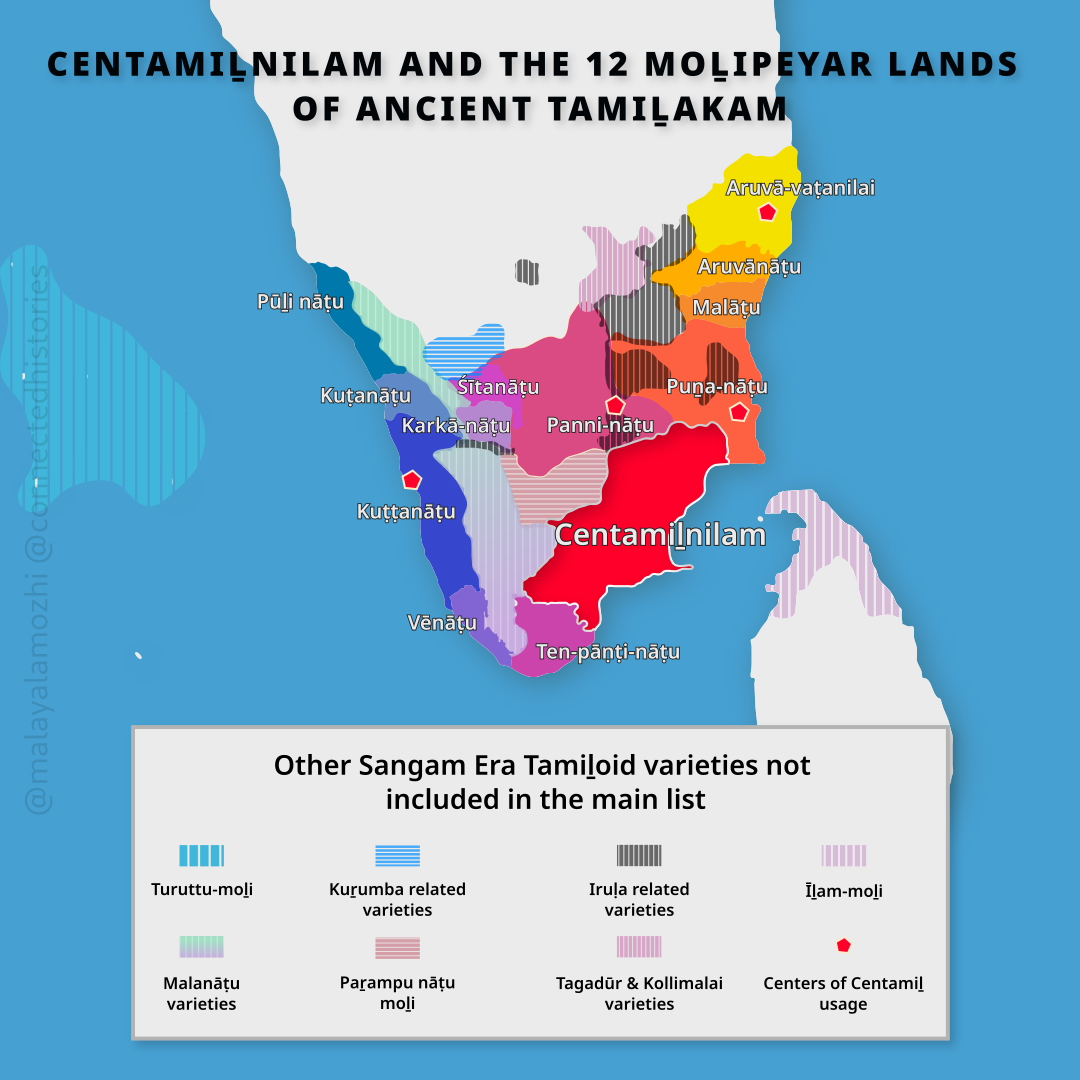Old Tamil language on:
[Wikipedia]
[Google]
[Amazon]
 Old Tamil is the period of the
Old Tamil is the period of the

 Old Tamil is the period of the
Old Tamil is the period of the Tamil language
Tamil (; ' , ) is a Dravidian language natively spoken by the Tamil people of South Asia. Tamil is an official language of the Indian state of Tamil Nadu, the sovereign nations of Sri Lanka and Singapore, and the Indian territory o ...
spanning from 300 BCE to 700 CE. Prior to Old Tamil, the period of Tamil linguistic development is termed as Pre Tamil. After the Old Tamil period, Tamil becomes Middle Tamil
Middle Tamil is the form of the Tamil language that existed from the 8th to the 15th century.
The development of Old Tamil into Middle Tamil, which is generally taken to have been completed by the 8th century, was characterised by a number of ...
. The earliest records in Old Tamil are inscriptions from between the 3rd and 1st century BCE in caves and on pottery. These inscriptions are written in a variant of the Brahmi script
Brahmi (; ; ISO: ''Brāhmī'') is a writing system of ancient South Asia. "Until the late nineteenth century, the script of the Aśokan (non-Kharosthi) inscriptions and its immediate derivatives was referred to by various names such as 'lath' ...
called Tamil Brahmi
Tamil-Brahmi, also known as Tamizhi or Damili, was a variant of the Brahmi script in southern India. It was used to write inscriptions in the early form of Old Tamil.Richard Salomon (1998) ''Indian Epigraphy: A Guide to the Study of Inscriptio ...
. The earliest long text in Old Tamil is the ''Tolkāppiyam
''Tolkāppiyam'', also romanised as ''Tholkaappiyam'' ( ta, தொல்காப்பியம், ''lit.'' "ancient poem"), is the most ancient extant Tamil grammar text and the oldest extant long work of Tamil literature. The surviving manus ...
'', an early work on Tamil grammar and poetics, whose oldest layers could be as old as the mid 2nd century BCE.Zvelebil, K. ''The Smile of Murugan: On Tamil Literature of South '' p.XX Old Tamil preserved many features of Proto-Dravidian, the earliest reconstructed form of the Dravidian including inventory of consonants, the syllable structure, and various grammatical features.
History
According to Bhadriraju Krishnamurti, Tamil, as a Dravidian language, descends from Proto-Dravidian, aproto-language
In the tree model of historical linguistics, a proto-language is a postulated ancestral language from which a number of attested languages are believed to have descended by evolution, forming a language family. Proto-languages are usually unattes ...
. Linguistic reconstruction suggests that Proto-Dravidian was spoken around the third millennium
A millennium (plural millennia or millenniums) is a period of one thousand years, sometimes called a kiloannus, kiloannum (ka), or kiloyear (ky). Normally, the word is used specifically for periods of a thousand years that begin at the starting ...
BCE, possibly in the region around the lower Godavari
The Godavari ( IAST: ''Godāvarī'' �od̪aːʋəɾiː is India's second longest river after the Ganga river and drains into the third largest basin in India, covering about 10% of India's total geographical area. Its source is in Trimbakesh ...
river basin in peninsular India. The material evidence suggests that the speakers of Proto-Dravidian were of the culture associated with the Neolithic
The Neolithic period, or New Stone Age, is an Old World archaeological period and the final division of the Stone Age. It saw the Neolithic Revolution, a wide-ranging set of developments that appear to have arisen independently in several pa ...
complexes of South India
South India, also known as Dakshina Bharata or Peninsular India, consists of the peninsular southern part of India. It encompasses the Indian states of Andhra Pradesh, Karnataka, Kerala, Tamil Nadu, and Telangana, as well as the union terr ...
. The earliest epigraphic
Epigraphy () is the study of inscriptions, or epigraphs, as writing; it is the science of identifying graphemes, clarifying their meanings, classifying their uses according to dates and cultural contexts, and drawing conclusions about the wr ...
attestations of Tamil are generally taken to have been written from the 2nd century BCE.
Among Indian languages, Tamil has the most ancient non-Sanskrit
Sanskrit (; attributively , ; nominally , , ) is a classical language belonging to the Indo-Aryan languages, Indo-Aryan branch of the Indo-European languages. It arose in South Asia after its predecessor languages had Trans-cultural diffusion ...
ic Indian literature. Scholars categorise the attested history of the language into three periods: Old Tamil (300 BCE–700 CE), Middle Tamil (700–1600) and Modern Tamil (1600–present). In November 2007, an excavation at Quseir al Qadim revealed Ancient Egyptian pottery dating back to first century BCE with ancient Tamil Brahmi inscriptions. There are a number of apparent Tamil loanwords in Biblical Hebrew dating to before 500 BCE, the oldest attestation of the language.Rabin, C. ''Proceedings of the Second International Conference Seminar of Tamil Studies'', p. 438 John Guy states that Tamil was the lingua franca
A lingua franca (; ; for plurals see ), also known as a bridge language, common language, trade language, auxiliary language, vehicular language, or link language, is a language systematically used to make communication possible between groups ...
for early maritime traders from India.
Literary work
Many literary works in Old Tamil have also survived. These include a corpus of 2,381 poems collectively known asSangam literature
The Sangam literature (Tamil: சங்க இலக்கியம், ''caṅka ilakkiyam'';) historically known as 'the poetry of the noble ones' (Tamil: சான்றோர் செய்யுள், ''Cāṉṟōr ceyyuḷ'') connotes ...
. These poems are usually dated to between the 3rd century BCE and 5th century CE, which makes them the oldest extant body of secular literature in India. Other literary works in Old Tamil include Thirukural
The ''Tirukkuṟaḷ'' ( ta, திருக்குறள், lit=sacred verses), or shortly the ''Kural'' ( ta, குறள்), is a classic Tamil language text consisting of 1,330 short couplets, or kurals, of seven words each. The text ...
, Silappatikaram and Maṇimēkalai, and a number of ethical and didactic texts, written between the 5th and 8th centuries.
Features
Old Tamil preserved many features of Proto-Dravidian, including inventory of consonants, the syllable structure, and various grammatical features. Amongst these was the absence of a distinct present tense – like Proto-Dravidian, Old Tamil only had two tenses, the past and the "non-past". Old Tamil verbs also had a distinct negative conjugation (e.g. ' aːɳeːn () (കാണേൻ)) "I do not see", ' aːɳoːm( () (കാണോം) "we do not see") Nouns could take pronominal suffixes like verbs to express ideas: e.g. ' eɳɖiɾeːm () (പെണ്ടിരേം) "we are women" formed from ' eɳɖiɾ () (പെണ്ടിർ) "women" and the first person plural marker ''-'' ()(എം). Despite the significant amount of grammatical and syntactical change between Old, Middle and Modern Tamil, Tamil demonstrates grammatical continuity across these stages: many characteristics of the later stages of the language have their roots in features of Old Tamil.Regional varieties
The Tolkappiyam mentions about 12 moḻipeyar lands apart from the region where Centamil was spoken. Tolkappiyam 881 also mentions about dialectical words called Ticaicol. However, being a language with an established literature, it served as the administrative language all across theTamilakam
Tamiḻakam (Tamil: தமிழகம்; Malayalam: തമിഴകം), refers to the geographical region inhabited by the ancient Tamil people, covering the southernmost region of the Indian subcontinent. Tamilakam covered today's Tamil Nad ...
. Ulloor S. Parameswara Iyer
Ulloor S. Parameswara Iyer (Malayalam: ഉള്ളൂർ എസ്. പരമേശ്വര അയ്യർ; 6 June 1877 – 15 June 1949), born Sambasivan but popularly known as Ulloor, was an Indian poet of Malayalam literature and a histo ...
in his work, Kerala Sahithya Charithram names these regions. Senavaraiyar and Mayilainatar, both interpret almost similar names for these twelve Tamil dialectical regions of Old Tamil.

See also
* Old Tamil words attested in Biblical Hebrew * Old Tamil words attested in Ancient GreekNotes
References
Sources
* * * * * * * * * * *{{Cite book, last=Zvelebil, first=Kamil, url=https://books.google.com/books?id=degUAAAAIAAJ&q=info:3mNeiVqlnhoJ:scholar.google.com/&pg=PR9, title=The Smile of Murugan: On Tamil Literature of South India, date=1973, publisher=BRILL, isbn=978-90-04-03591-1, language=en Tamil language Languages attested from the 3rd century BC Languages extinct in the 6th century 6th-century disestablishments in Asia